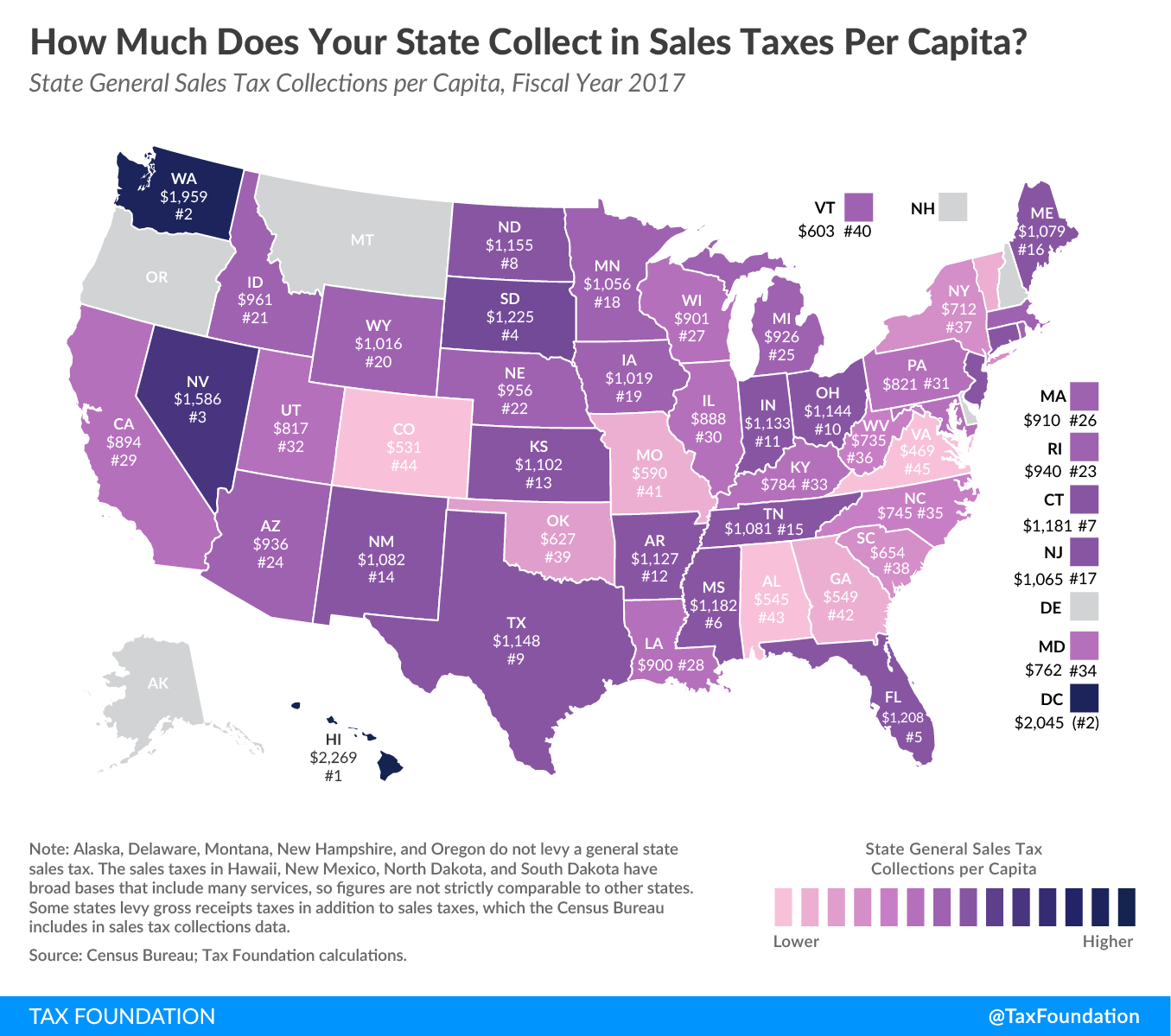This week’s state tax map examines state sales tax collections per capita. Forty-five states and the District of Columbia have state-levied sales taxes, while five states–Alaska, Delaware, Montana, New Hampshire, and Oregon–do not collect sales taxes at the state level. (Of these, Alaska is the only state that allows localities to charge local sales taxes.)
In fiscal year (FY) 2017, the highest state sales taxA sales tax is levied on retail sales of goods and services and, ideally, should apply to all final consumption with few exemptions. Many governments exempt goods like groceries; base broadening, such as including groceries, could keep rates lower. A sales tax should exempt business-to-business transactions which, when taxed, cause tax pyramiding. collections per capita were found in Hawaii ($2,269), the District of Columbia ($2,045), Washington ($1,959), Nevada ($1,586), South Dakota ($1,225), and Florida ($1,208). Hawaii and South Dakota have broad sales tax bases that include many services, contributing to high collections per capita. (Hawaii’s sales tax baseThe tax base is the total amount of income, property, assets, consumption, transactions, or other economic activity subject to taxation by a tax authority. A narrow tax base is non-neutral and inefficient. A broad tax base reduces tax administration costs and allows more revenue to be raised at lower rates. is broader than economists recommend, applying not just to final consumer goods and services, but also to many business-to-business transactions, resulting in harmful tax pyramiding.)
The lowest state sales taxA tax is a mandatory payment or charge collected by local, state, and national governments from individuals or businesses to cover the costs of general government services, goods, and activities. collections per capita are found in Virginia ($469), Colorado ($531), Alabama ($545), Georgia ($549), and Missouri ($590). In these states, a combination of low rates and relatively narrow bases contributes to low collections per capita.
In most states, narrow sales tax bases make the sales tax less productive (from a revenue standpoint) than it could be. Many states exempt certain goods (like groceries or clothing) from the sales tax for political reasons, while excluding many consumer services (such as dry-cleaning or barber services). Since the 1950s, purchases of consumer services have grown, while purchases of consumer goods have declined, as a share of total U.S. personal consumption. This trend has contributed to the erosion of states’ sales tax bases over time, and the narrowing of sales tax bases puts upward pressure on sales tax rates.
Most states will find that broadening their sales tax base to include more final consumer goods and services will create newfound flexibility to reduce tax rates. Additionally, an appropriately-broad sales tax base improves neutrality by moving toward a system that taxes all final consumer goods and services evenly, and it makes tax administration simpler while generating a more stable stream of revenue.
Note: This is part of a map series in which we examine per capita state tax collections
- How High are State and Local Tax Collections in Your State?
- How Much Does Your State Collect in Corporate Income Taxes Per Capita?
- How Much Does Your State Collect in Individual Income Taxes Per Capita?
- How Much Does Your State Collect in Property Taxes Per Capita?
- How Much Does Your State Collect in Excise Taxes Per Capita?
